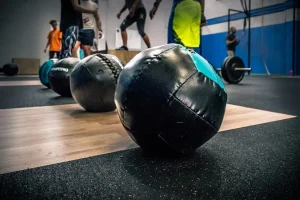Let’s talk about medicine ball weight – it’s a big deal in the fitness world. You know those bouncy, versatile balls people use in workouts? Well, their weight isn’t just a number; it’s a game-changer for your fitness routine.
Imagine this: you’re at the gym eyeing those medicine balls. The weight isn’t just about how heavy they feel; it’s about tailoring your workout. Whether you’re a beginner or a fitness buff, picking the right medicine ball weight can make or break your routine.
Why does it matter, you ask? Well, the weight dictates the intensity and effectiveness of your exercises. It’s like choosing the right gear for a hike – you want something that challenges you but won’t leave you wiped out halfway through.
We’re diving deep into this world of medicine ball weight. From understanding how different weights affect your exercises to pinpointing the exact benefits tied to specific weights, we’ve got you covered.
So, buckle up and join us on this journey into the realm of “medicine ball weight.” We’re unlocking the secrets to a more personalized and effective fitness experience. Let’s roll!
What’s the right weight for a medicine ball?

The right weight for a medicine ball depends on various factors, including your fitness level, goals, and the specific exercises you plan to do. Medicine balls come in a range of weights, typically starting from 2 pounds (0.9 kg) and going up to 30 pounds (13.6 kg) or more.
Here are some general guidelines:
- Beginners: If you are new to exercising with medicine balls or have a low fitness level, start with a lighter weight, such as 2 to 6 pounds (0.9 to 2.7 kg).
- Intermediate: For individuals with some fitness experience, a medium-weight medicine ball in the range of 8 to 12 pounds (3.6 to 5.4 kg) may be appropriate.
- Advanced: Advanced individuals or those looking to increase the intensity of their workouts can use heavier medicine balls, ranging from 15 pounds (6.8 kg) and above.
- Exercise Specific: Consider the specific exercises you plan to do. Some exercises, like medicine ball slams or throws, may require a heavier ball, while others, like twists or Russian twists, may be better with a lighter ball.
It’s crucial to choose a weight that allows you to perform the exercises with proper form and control. If the weight is too light, you might not get the desired workout intensity. On the other hand, using a weight that is too heavy can lead to poor form, increasing the risk of injury.
If possible, it’s a good idea to try out different weights at a gym or fitness store to determine the most suitable weight for your current fitness level and goals. Additionally, consulting with a fitness professional can provide personalized recommendations based on your individual needs and abilities.
Can a heavier ball be more effective?
A heavier medicine ball can be more effective for certain purposes and exercises, but it’s essential to consider your fitness level, goals, and the specific exercise you’re performing.
Benefits of a heavier medicine ball:
- Increased Intensity: A heavier ball can add more resistance, making exercises more challenging. This can be beneficial for building strength and power.
- Muscle Engagement: Heavier balls require more muscle engagement to control and move, leading to greater muscle activation and development.
- Progressive Overload: Using a heavier ball over time can help you progress in your workouts and challenge your muscles to adapt, leading to strength gains.
Does the ball weight suit specific goals?

Yes, the weight of the medicine ball can be tailored to specific fitness goals. Different ball weights are more appropriate for various types of exercises and fitness objectives. Here are some general guidelines based on specific goals:
- Strength and Power:
-
- Heavier Balls (10 pounds and above): These are suitable for exercises that focus on building strength and power, such as medicine ball slams, overhead throws, and chest passes. The added resistance challenges your muscles, promoting strength development.
- Endurance and Cardiovascular Fitness:
-
- Moderate Weight (6 to 10 pounds): For exercises that involve repetitive movements, such as medicine ball twists or partner passes, a moderate weight can help improve endurance and cardiovascular fitness without overly fatiguing the muscles.
- Core Stability and Balance:
-
- Lighter to Moderate Weight (2 to 6 pounds): Lighter medicine balls are often used for core-specific exercises, including Russian twists, sit-ups, and leg raises. These exercises emphasize control, stability, and engagement of the core muscles.
- Speed and Agility:
-
- Lighter Balls (2 to 6 pounds): Lighter medicine balls are suitable for exercises that involve quick, explosive movements, such as rotational throws, side-to-side slams, and rapid passes. These activities enhance speed, agility, and coordination.
- Rehabilitation and Mobility:
-
- Lightest Weight (2 pounds or less): For individuals recovering from injuries or focusing on mobility work, using a very light medicine ball can be beneficial. Gentle tossing and catching exercises can help improve range of motion and promote healing without placing excessive stress on the body.
It’s essential to note that these are general guidelines, and individual preferences and fitness levels vary. When selecting a medicine ball weight, consider your current strength, fitness goals, and the specific exercises you plan to perform.
It’s often a good idea to start with a moderate weight and adjust based on your comfort, form, and progression. Consulting with a fitness professional can provide personalized guidance tailored to your unique needs and objectives.
Does a heavier ball intensify workouts?
Yes, using a heavier medicine ball can intensify workouts by providing increased resistance, which challenges your muscles more and requires greater effort to perform exercises.
This added resistance can lead to several benefits:
- Increased Strength: The primary advantage of using a heavier medicine ball is the promotion of strength development. The resistance forces your muscles to work harder during exercises, contributing to increased muscle strength over time.
- Enhanced Power: Many explosive movements, such as medicine ball slams or throws, become more challenging and, therefore, more effective when using a heavier ball. This can lead to improvements in power, which is the ability to generate force quickly.
- Caloric Expenditure: Working with a heavier resistance requires more energy, potentially increasing the overall caloric expenditure of your workout. This can be beneficial for individuals looking to burn more calories and support weight management.
- Progressive Overload: Incrementally increasing the weight of your medicine ball over time provides a method of progressive overload, a key principle in fitness. Progressive overload involves gradually increasing the resistance to continuously challenge the body, leading to ongoing improvements in strength and fitness.
While using a heavier ball can be beneficial, it’s crucial to balance intensity with safety and proper form. Choosing a weight that is excessively heavy for your current fitness level can increase the risk of injury and compromise your ability to maintain good form during exercises.
It’s advisable to start with a weight that allows you to perform exercises with control and proper technique. As your strength and fitness level improve, you can gradually progress to heavier medicine balls.
Always listen to your body, and if you experience pain or discomfort beyond normal muscle fatigue, consider using a lighter weight or seeking guidance from a fitness professional.
Conclusion
Choosing the right medicine ball weight is essential for optimizing workout effectiveness and safety. The weight of the medicine ball should align with specific fitness goals and the nature of exercises.
Heavier medicine balls intensify workouts, promoting strength, power, and calorie expenditure. However, it’s crucial to prioritize proper form, gradually progressing to heavier weights as fitness levels improve. Tailoring medicine ball weight to individual needs enhances the overall workout experience, contributing to a well-rounded and goal-specific fitness routine.

